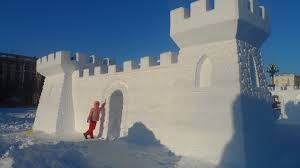Until now
I have never built a snow castle. Sure, I’ve constructed my fair share of moderately pathetic, single-walled “forts” but never anything worthy of economic law. With Trump’s win comes my fairly predictable sojourn to America’s ‘neighbor to the North’. Just kidding. I planned to visit Montreal a few months ago and I’ll be back on U.S. soil in-time for the inauguration. And since I’m determined to enjoy myself amidst the knee-height drifts and double-digit negative temperature, fun has been had. Namely, the snow castle.
Trump’s win comes my fairly predictable sojourn to America’s ‘neighbor to the North’. Just kidding. I planned to visit Montreal a few months ago and I’ll be back on U.S. soil in-time for the inauguration. And since I’m determined to enjoy myself amidst the knee-height drifts and double-digit negative temperature, fun has been had. Namely, the snow castle.
Snow Castle: Instructions
I like to research. Like, A LOT. So when the idea of snow castles came up, I quickly found a number of seemingly reputable sources to guide us. (Here was the best resource!)
Through hands-on snow castle fabrication, here are a few considerations I found notable:
- Bricks: size; relative wet-factor of snow: the snow must be on the heavy wet side.
- Layout: from plotting the structure to ensuring architectural integrity (ha!).
- Patching: Wettish snow (same as brick snow) is a necessity to fill-in bare spaces.

I noticed that as we were building, switching tasks every so often, we increasingly became more proficient. New ideas to improve efficiency and speed! Towards the end of our first day, I worked exclusively on bricks (mitten issues caused challenges with stacking bricks and patching) and I got good. Real freakin’ good. I discovered a highly technical snow brick-making process, creating perfectly shaped bricks that were just the right mixture of heavy snow (a requirement! No fluffy stuff allowed; it just breaks apart) and beating it down into the bucket, turned snow brick mold. Specialization, or limiting production or focus to one task, results in greater efficiency. By focusing production on bricks, I could immediately make improvements in my strategy.
Specialization: basically, doing what you suck the least at
With specialization, society can get the biggest bang for their buck. Resources are limited (in terms of money, raw materials, time, etc.). If everyone is doing what they suck the least at, their making the best use of their skills, resources, etc. and can generate the greatest output. Of course in real life (“IRL”), there might be additional considerations, but for now, all things equal.
Output is increased because tasks are separated. This division of labor, means that production gets better and better because as one focuses on a single task, they are in essence practicing that task over and over, or learning by doing, and will likely increase their mastery as a result of the continued practice.
This enables efficient production and an incentive to trade, both on a small scale and large. For example, Hawaii’s resources are much better suited to the production of mangoes. Nebraska would be better off staying out of the mango-market, but perhaps trading homegrown corn, for Hawaii mangoes.
Wages
On a large scale, some firms specialize components of their production process based on a particular location’s resources. This geographical specialization has recently garnered a lot of media attention, as U.S. car manufacturers’ plans (real or alleged by you-know-who on #twitter) to increase production in countries with lower wages has come under recent scrutiny. This move would effectively lower these manufacturers’ production costs, which could result in better prices for potential consumers OR more profit for the company (or a mix of the two).
Do you agree with this? What do you think of companies who increasingly employ workers abroad?






